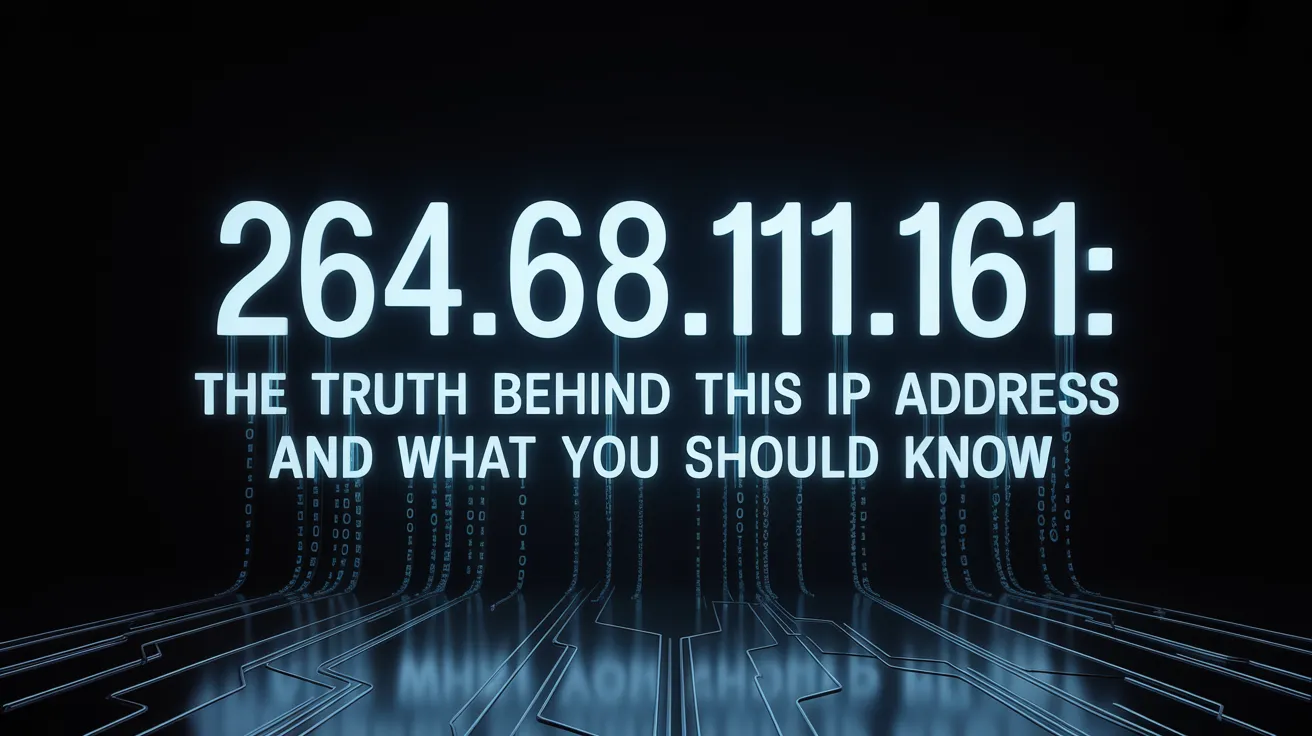Table of Contents
In the vast digital landscape, every device that connects to the internet is assigned an IP address.
These numbers are more than just random sequences — they are the lifeblood of internet communication, linking devices together for seamless data transfer.
However, not all IP addresses are what they seem, and some, like 264.68.111.161, can spark confusion or even cause concern.
At first glance, this address may look like a typical IPv4 address. But what happens when you dig deeper? In this article, we’ll explore the implications of 264.68.111.161, why it’s causing confusion, and what you can do if you come across it.
What is an IP Address?

Before diving into the specifics of 264.68.111.161, it’s essential to understand the basics of IP addresses. An Internet Protocol address (IP address) is a unique numerical identifier assigned to each device connected to a network.
It helps route data to its correct destination, ensuring that your messages, files, and requests reach the appropriate device.
There are two types of IP addresses:
- IPv4: The traditional 32-bit format consisting of four octets (e.g., 192.168.1.1). It provides over 4 billion possible addresses.
- IPv6: The newer 128-bit format designed to address IPv4’s limitations. It’s expressed in hexadecimal and can generate an almost infinite number of unique addresses.
Understanding the Structure of 264.68.111.161
At first glance, 264.68.111.161 might appear to be a standard IPv4 address. However, as we dive deeper, we see that it doesn’t fit the typical criteria for valid IPv4 addresses.
Read also: Why Are Sonos Speakers So Expensive
Why 264.68.111.161 Is Invalid
An IPv4 address is composed of four numbers, each ranging from 0 to 255, separated by periods. This means each of the four octets in an IPv4 address must fall within this range.
In 264.68.111.161, the first number, 264, exceeds the allowed range of 255, which immediately renders the address invalid.
Valid IPv4 Range
IPv4 addresses must follow this structure:
- The first octet: 0 to 255
- The second octet: 0 to 255
- The third octet: 0 to 255
- The fourth octet: 0 to 255
Since 264 is beyond the valid range, 264.68.111.161 cannot be used as a functional IP address on the internet.
Common Misunderstandings About Invalid IP Addresses
Sometimes, invalid IP addresses like 264.68.111.161 can cause confusion. Here are a few common misconceptions:
Confusing IP Addresses with Other Formats
One of the most frequent mistakes is confusing IP addresses with domain names or URLs. Domain names, such as example.com, are the human-readable names for websites, whereas IP addresses are numerical labels used by computers to locate each other.
Temporary or Dynamic IPs
Another issue arises with dynamic IP addresses. These addresses can change over time, leading to confusion when tracking devices. However, 264.68.111.161 would still remain invalid regardless of whether it’s static or dynamic.
What Could Cause 264.68.111.161 to Appear?
While this IP address is technically invalid, it may still show up in various contexts, particularly in logs or error reports. Here are a few reasons why:
Spoofing Attempts
In the world of cyberattacks, attackers often use IP spoofing to disguise their true identity. An invalid IP like 264.68.111.161 might be used to throw off detection systems.
Misconfigurations
Network tools or software misconfigurations might cause an invalid IP address to appear. It could be the result of a typographical error, a faulty DNS lookup, or a bug in the software.
Testing and Simulation
In educational or testing environments, fictional IP addresses like 264.68.111.161 may be used for simulations or demonstrations. These non-functioning addresses help to explain how IP addressing works without impacting real systems.
Security Concerns with Invalid IP Addresses
While 264.68.111.161 is not a valid address, any appearance of incorrect or spoofed IPs in your logs could signal potential security threats.
IP Spoofing and Cybersecurity Risks
IP spoofing is a common technique used in Denial of Service (DoS) attacks or man-in-the-middle (MitM) attacks. By sending requests with a fake IP address, attackers can bypass security systems and gain unauthorized access.
What To Do if You Encounter Invalid IPs
If you notice an invalid IP like 264.68.111.161 in your network logs, follow these steps:
- Check for Typos: Verify that the IP isn’t a simple mistake in your logging.
- Run Security Scans: Use antivirus and anti-malware software to scan for any potential threats.
- Review Firewall Settings: Ensure that your firewall is blocking suspicious IP addresses and preventing unauthorized access.
How to Track IP Addresses for Security
Understanding IP addresses is key to securing your network. Here’s how you can track and manage IP addresses to protect your systems:
Geolocation Tracking
While 264.68.111.161 can’t be tracked because it’s invalid, valid IP addresses can sometimes be geolocated. This means identifying the approximate physical location of the device using the IP address.
Use IP Lookup Tools
Tools like WHOIS and IP lookup services allow you to check the legitimacy of an IP address. These tools can help identify whether an address belongs to a known malicious actor or if it’s simply a misconfiguration.
How to Protect Your System from Spoofed IPs
Network Security is paramount when dealing with IP addresses. To protect your systems:
- Regular Updates: Ensure your firewall, routers, and other network devices are up to date.
- Use VPNs: A Virtual Private Network (VPN) can mask your real IP address, adding a layer of security.
- Monitor Network Traffic: Keep an eye on network logs for any unusual activity, such as invalid or spoofed IPs.
People also ask
Is 264.68.111.161 a Real IP Address?
No, 264 exceeds the IPv4 limit of 255, so this address is invalid.
Why Might 264.68.111.161 Appear in My Server Logs?
It could be the result of a misconfiguration, typo, or spoofing attempt.
Can 264.68.111.161 Be Used to Track Someone’s Location?
No, since it’s an invalid address, it cannot be used for geolocation.
What Tools Can Help Identify Fake IPs Like 264.68.111.161?
Use IP lookup services, WHOIS, and network monitoring software to detect and validate IP addresses.
Final Words
Though 264.68.111.161 may not be a valid IP address, its appearance underscores the importance of understanding how IP addresses work in the world of networking and cybersecurity.
Invalid addresses can sometimes indicate issues like misconfigurations or potential security threats, so it’s crucial to stay vigilant and ensure your network is secure.
By verifying IP addresses, using the right tools, and practicing good cybersecurity hygiene, you can protect your systems and ensure smooth and safe digital communication.

